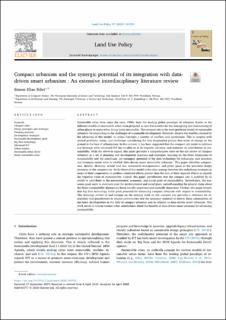| dc.description.abstract | Sustainable cities have, since the early 1990s, been the leading global paradigm of urbanism thanks to the different models of sustainable urban form proposed as new frameworks for the redesigning and restructuring of urban places to make urban living more sustainable. The compact city is the most preferred model of sustainable urbanism for responding to the challenges of sustainable development. However, despite the benefits claimed by the advocates of this model, its critics highlight a number of conflicts and contentions. This is coupled with several problems, issues, and challenges considering the very fragmented picture that arises of change on the ground in the face of urbanization. In this context, it has been suggested that the compact city needs to embrace and leverage what advanced ICT has to offer so as to improve, advance, and maintain its contribution to sustainability. With the above in regard, this paper provides a comprehensive state–of–the–art review of compact urbanism as a set of planning and development practices and strategies, focusing on the three dimensions of sustainability and the significant, yet untapped, potential of big data technology for enhancing such practices and strategies under what is labelled ‘data–driven smart sustainable urbanism.’ This paper identifies compactness, density, diversity, mixed land use, sustainable transportation, and green space as the prevalent design strategies of the compact city. At the heart of this model is the clear synergy between the underlying strategies in terms of their cooperation to produce combined effects greater than the sum of their separate effects as regards the tripartite value of sustainability. Indeed, this paper corroborates that the compact city is justified by its ability to contribute to the environmental, economic, and social goals of sustainability. Nevertheless, the economic goals seem to dominate over the environmental and social goals, notwithstanding the general claim about the three sustainability dimensions being equally important and mutually dependent. Further, this paper reveals that big data technology holds great potential for enhancing compact urbanism with respect to sustainability. This thorough review of and critique on the existing work on the compact city provides a reference for researchers and practitioners in related communities and the necessary material to inform these communities of the latest developments in the field of compact urbanism and its relation to data–driven smart urbanism. This work serves to inform various urban stakeholders about the benefits of data-driven smart solutions for advancing sustainability | en_US |

